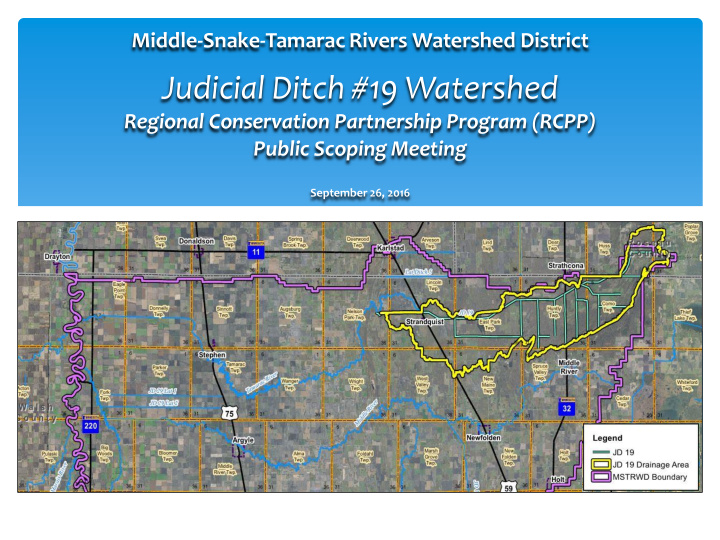



Middle-Snake-Tamarac Rivers Watershed District Judicial Ditch #19 Watershed Regional Conservation Partnership Program (RCPP) Public Scoping Meeting September 26, 2016 Will be modified – map from GIS – 6/16 EOD
Judicial Ditch #19 Watershed Public Scoping Meeting OBJECTIVES 1. Review Tamarac Project Work Team Progress 2. Overview - PL566 Planning process 3. Solicit Comments on the Resource Concerns 4. Inform Public of Future Steps
Judicial Ditch #19 Watershed Public Scoping Meeting AGENDA 1. Review Tamarac Project Work Team Progress 2. Introduce Study Area 3. Public Law 566 Planning Process Overview 4. Watershed Setting and Resource Concerns 5. Overview of Next Steps 6. Questions/Public Comment Period
Review Tamarac Project Work Team Progress
Tamarac River Watershed Area Middle-Snake-Tamarac Rivers Watershed District - 1,476 sq. mi. Tamarac River Watershed - 421 sq. mi.
1965 PL-566 Work Plan
Tamarac PL566 Impoundments Florian & East Park
Existing Plan View East Park WMA
Florian & East Park Selected Info (1965 Workplan) Florian East Park Drainage Area (sq mi) 197.31 70.06 Storage Capacity (ac-ft) (ac-ft) inches (ac-ft) inches Sediment 125 0.012 71 0.019 Recreation 172 0.016 0 0.000 Wildlife 0 0.000 3329 0.891 Flood Water 800 0.076 4520 1.210 Total 1097 0.104 7920 2.121 Between High & Low Stages 379 0.036 2290 0.613 Surface Area (acres) (acres) (acres) Sediment 26 150 Recreation 50 0 Wildlife 0 1720 10 yr Freq Pool 76 2000 Design Freq Pool 104 2310 Volume of Fill (embankment) (cy) 35097 229584 Elevation Top of Dam (ft 1929 MSL) 929.1 1104.9 Max Height (ft) 31.6 14.9
Tamarac River PWT Review • PWT Focused Mainly on East Park WMA (Nelson Slough) • Expansion/Modification/Repair • Alternatives Discussed & Analyzed • City of Stephen – 100 Year Flood Plain • Stream Erosion – Tamarac River Watershed Area • No Purpose and Need Identified
Regional Conservation Partnership Program (RCPP) • 2014 Farm Bill • Red River Retention Authority awarded $12M • RRRA approved 20 Watershed Planning Efforts • 12 Minnesota, 8 North Dakota • MSTRWD entered into Cooperative Agreements with NRCS • Judicial Ditch #19 and Judicial Ditch #14
Study Area Middle-Snake-Tamarac Rivers Watershed District - 1,476 sq. mi. Tamarac River Watershed - 421 sq. mi. Judicial Ditch #19 Watershed – 104 sq. mi.
Study Area
RCPP Planning Process INITIATE PLANNING Discuss purpose and need for project with sponsors/Initiate study. Step 1 - IDENTIFY PROBLEMS, OPPORTUNITIES & CONCERNS Identify the need for the proposed action (quantify, extent, magnitude, timing, frequency etc.) Step 2 - DETERMINE OBJECTIVES Write purpose and need statement and Write scope of plan-EA/EIS Step 3 - INVENTORY RESOURCES Conduct detailed resource inventories and watershed assessment Economics, social effects, Archeological and historic resources Engineering/Geology/Support maps Document problems Step 4 - ANALYZE RESOURCE DATA Geology, Hydrology & Hydraulics, Cultural, Economics and Social Step 5 - FORMULATE ALTERNATIVES Develop reasonable alternatives, mitigation strategies and costs (Preliminary plans) Step 6 - EVALUATE ALTERNATIVES Env . Resources, Geotechnical, Hydrology & Hydraulics, Economics, Significance of effects,… Step 7 - MAKE DECISIONS (EA/EIS, Public Involvement,…)
RCPP Planning Process - NEPA RCPP planning process will follow National Environmental Policy Act (NEPA) guidelines 40 CFR 1506.6 – Public Involvement Primary Goal Ensure all interested and affected parties are aware of the proposed action (a) “make diligent efforts to involve the public in preparing and implementing their NEPA procedures.”
Why RCPP? COST SHARE BREAKDOWN 30% LOCAL 70% NRCS
Watershed Setting and Known Resource Concerns
Problems – Flooding/Flood Damages Como Twp. Agriculture Field Flooding
Natural Resource and Water Quality Concerns Channel instability Lack of riparian buffers Degradation and loss of existing grassland and wetland habitats (ex. CRP conversion) Soil erosion (wind and water) from upland sources Degraded soil health
Problems East Park WMA (Nelson Slough) Capacity/Operation/Outlet Sandbagging Overflows in 1997 JD #19 Channel Instability Water Quality/Erosion/Sediment
JD #19 Study Area – Public Land Resources Natural Resource Goals Middle-Snake-Tamarac Rivers Watershed 10-yr Plan (2011) Restore and protect unique ecological values and recreational opportunities within the district Maintain/improve water quality of rivers, streams, lakes, and groundwater resources. Protect wetlands and channels from sedimentation, and maintain the soil productivity of ag lands with the district Promote district goals to residents within the district as well as local, state, and federal agencies. JD #19 Study Area – Water Resources JD #19 Study Area – National Wetland Inventory
Overview of Next Steps
Watershed Planning Timeline 1-3 Months 6-12 Months 3-6 Months 12+ Months Plan of Work Finalize Ex. H&H Purpose & Need Alternative Develop Team Without Project Scope EA Screening Geotech Feasibility Report Conditions Field Survey Economics: Impacted Lands Define Concerns Ex. H&H Modeling Preliminary Alternatives for Public Meeting Field Inventory Alternative Detailed Study Field Survey Begin Economics Screening H&H Begin H&H Preliminary Alternatives Cultural Review Detailed Survey, Geotech, Design
Questions/Comments/ Form Completion
Public Input
Public Input
Questions
Recommend
More recommend